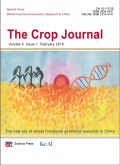- 钛学术文献服务平台 \
- 学术期刊 \
- 农业科学期刊 \
- 农作物期刊 \
- 作物学报(英文版)期刊 \
null
Harness the power of genomic selection and the potential of germplasm in crop breeding for global food security in the era with rapid climate change
基本信息来源于合作网站,原文需代理用户跳转至来源网站获取
摘要:
Crop genetic improvements catalysed population growth, which in turn has increased the pressure for food security. We need to produce 70%more food to meet the demands of 9.5 billion people by 2050. Climate changes have posed challenges for global food supply, while the narrow genetic base of elite crop cultivars has further limited our capacity to increase genetic gain through conventional breeding. The effective utilization of genetic resources in germplasm collections for crop improvement is crucial to increasing genetic gain to address challenges in the global food supply. Genomic selection (GS) uses genome-wide markers and phenotype information from observed populations to establish associations, followed by genome-wide markers to predict phenotypic values in test populations. Characterizing an extensive germplasm collection can serve a dual purpose in GS, as a reference population for predicting model, and mining desirable genetic variants for incorporation into elite cultivars. New technologies, such as high-throughput genotyping and phenotyp-ing, machine learning, and gene editing, have great potential to contribute to genome-assisted breeding. Breeding programmes integrating germplasm characterization, GS and emerging technologies offer promise for accelerating the development of cultivars with improved yield and enhanced resistance and tolerance to biotic and abiotic stresses. Finally, scientifically informed regulations on new breeding technologies, and increased sharing of genetic resources, genomic data, and bioinformatics expertise between developed and developing economies will be the key to meeting the challenges of the rapidly changing climate and increased demand for food.

推荐文章
期刊_丙丁烷TDLAS测量系统的吸收峰自动检测
带间级联激光器
调谐半导体激光吸收光谱
雾剂检漏 中红外吸收峰 洛伦兹光谱线型
不同盐度、温度及光照对漂浮浒苔生理生态的影响
浒苔
盐度
温度
光照
生理生态
期刊_联合空间信息的改进低秩稀疏矩阵分解的高光谱异常目标检测
高光谱图像
异常目标检测 低秩稀疏矩阵分解 稀疏矩阵 残差矩阵
内容分析
关键词云
关键词热度
相关文献总数
(/次)
(/年)
引文网络
引文网络
二级参考文献 (112)
共引文献 (5)
参考文献 (125)
节点文献
引证文献 (0)
同被引文献 (0)
二级引证文献 (0)
1919(1)
- 参考文献(1)
- 二级参考文献(0)
1959(1)
- 参考文献(1)
- 二级参考文献(0)
1978(1)
- 参考文献(0)
- 二级参考文献(1)
1980(1)
- 参考文献(0)
- 二级参考文献(1)
1987(1)
- 参考文献(0)
- 二级参考文献(1)
1989(1)
- 参考文献(1)
- 二级参考文献(0)
1990(1)
- 参考文献(0)
- 二级参考文献(1)
1991(1)
- 参考文献(0)
- 二级参考文献(1)
1996(1)
- 参考文献(1)
- 二级参考文献(0)
1997(2)
- 参考文献(2)
- 二级参考文献(0)
2001(3)
- 参考文献(1)
- 二级参考文献(2)
2002(1)
- 参考文献(0)
- 二级参考文献(1)
2003(3)
- 参考文献(0)
- 二级参考文献(3)
2004(2)
- 参考文献(0)
- 二级参考文献(2)
2005(6)
- 参考文献(1)
- 二级参考文献(5)
2006(3)
- 参考文献(3)
- 二级参考文献(0)
2007(3)
- 参考文献(1)
- 二级参考文献(2)
2008(4)
- 参考文献(1)
- 二级参考文献(3)
2009(4)
- 参考文献(2)
- 二级参考文献(2)
2010(5)
- 参考文献(1)
- 二级参考文献(4)
2011(8)
- 参考文献(4)
- 二级参考文献(4)
2012(17)
- 参考文献(11)
- 二级参考文献(6)
2013(24)
- 参考文献(6)
- 二级参考文献(18)
2014(38)
- 参考文献(13)
- 二级参考文献(25)
2015(36)
- 参考文献(11)
- 二级参考文献(25)
2016(13)
- 参考文献(11)
- 二级参考文献(2)
2017(15)
- 参考文献(12)
- 二级参考文献(3)
2018(21)
- 参考文献(21)
- 二级参考文献(0)
2019(19)
- 参考文献(19)
- 二级参考文献(0)
2020(1)
- 参考文献(1)
- 二级参考文献(0)
2020(1)
- 参考文献(1)
- 二级参考文献(0)
- 引证文献(0)
- 二级引证文献(0)
引文网络交叉学科
相关学者/机构
期刊影响力
作物学报(英文版)
主办单位:
中国作物学会
中国农业科学院作物科学研究所
中国科技出版传媒股份有限公司
出版周期:
双月刊
ISSN:
2095-5421
CN:
10-1112/S
开本:
16开
出版地:
北京市海淀区中关村南大街12号
邮发代号:
80-668
创刊时间:
2013
语种:
eng
出版文献量(篇)
556
总下载数(次)
0
总被引数(次)
870
期刊文献
相关文献
推荐文献
- 期刊分类
- 期刊(年)
- 期刊(期)
- 期刊推荐

 免费查重
免费查重










